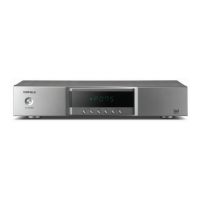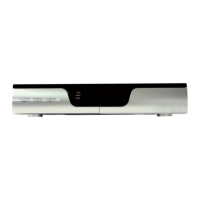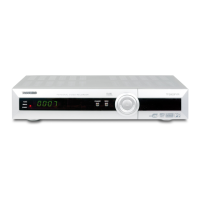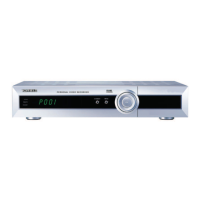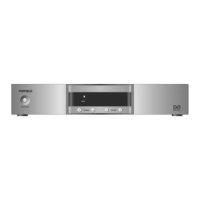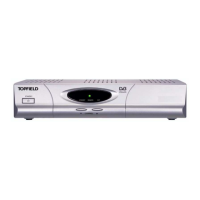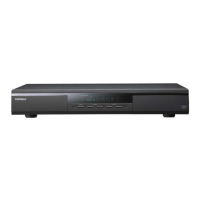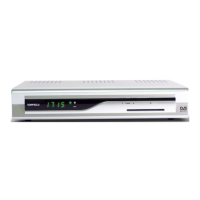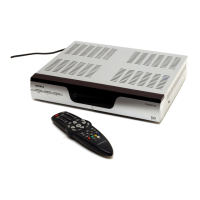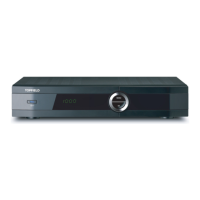
Do you have a question about the Topfield TF 520 PVRc and is the answer not in the manual?
Lists the primary capabilities of the digital receiver.
Explains how to operate the receiver using its controls.
Details the buttons and indicators on the front of the receiver.
Describes the functions of the remote control buttons.
Information regarding the use of subscription cards for pay services.
Lists the items included with the digital receiver and how to check them.
Provides essential safety instructions for operating the device.
Details the various connectors located on the back of the receiver.
Guides on how to connect the receiver to a television and other devices.
Explains how to connect the receiver to the broadcast signal source.
Outlines different methods for connecting the receiver to a TV.
Instructions for connecting the receiver to a video recorder.
Steps for the initial power-on and setup of the receiver.
Step-by-step guide to finding available TV and radio services.
Procedure for restoring the receiver to its original factory configuration.
How to remove all stored service information from the receiver.
How to configure menu, subtitle, and audio language preferences.
Setting the language for the receiver's on-screen menus.
Choosing preferred languages for subtitles.
Option for subtitle tracks specifically for the hearing impaired.
Selecting preferred languages for audio tracks.
Adjusting video and audio output configurations for the TV.
Configuring video resolution for high definition output.
Setting the display aspect ratio for wide-screen or standard TVs.
Options for adjusting the colour output format.
Connecting and managing output to other video devices.
Adjusting picture size to fit the TV screen.
Selecting the audio output mode (stereo, mono, etc.).
Setting the receiver's internal clock for accurate timers.
Features for restricting access to content based on age ratings.
Customizing the transparency and display properties of on-screen menus.
Enabling the feature to pause and rewind live TV.
How to adjust the audio volume using the remote.
Basic operations for viewing TV channels.
How to view and navigate the list of available TV and radio services.
Creating and managing personalized lists of preferred channels.
Accessing details about current and upcoming programs.
Choosing different audio languages or sound modes for a program.
Selecting preferred languages for subtitles.
Accessing teletext services for additional information.
Using the EPG to see schedules and set recordings.
Viewing multiple video feeds for a single program.
Detailed guide on pausing, rewinding, and replaying live TV.
Watching two channels simultaneously on one screen.
Creating, managing, and editing lists of favorite TV and radio services.
Instructions for navigating and using the virtual keyboard.
Steps to transfer settings and data between receivers using RS-232.
Instructions on how to record live TV programs.
How to start recording a program immediately.
Setting up scheduled recordings for future programs.
Using the EPG to schedule recordings.
Recording content while it is being time-shifted.
Recording encrypted programs, potentially requiring a subscription card.
Managing recorded programs stored on the hard drive.
Steps to remove unwanted recorded programs.
Options for organizing recorded files by name, time, or size.
Securing recordings to prevent unauthorized playback or deletion.
Changing the file name of a recorded program.
Creating new folders to organize recorded files.
Relocating recorded files into different folders.
Instructions on how to play back recorded content.
Using the progress bar to move through recorded playback.
Adjusting playback speed to slow motion.
Adjusting playback speed to fast motion.
Marking specific points within a recording for easy access.
Setting recordings to play back continuously.
Playing multiple recorded files one after another.
Playing back recordings that were encrypted.
Cutting or saving parts of a recorded program.
Creating a duplicate of a recorded file.
Playing MP3 audio files through the receiver.
Moving recorded files between the receiver and a computer via USB.
Preparing a new hard drive for use by the receiver.
Instructions for executing custom applications (TAPs) on the receiver.
Describes file management functions within the TAP interface.
How to find the current firmware version and system ID.
Updating the receiver's firmware using a USB connection.
Updating firmware using a serial (RS-232) connection.
Transferring firmware from one receiver to another via RS-232.
Updating the receiver's firmware wirelessly via broadcast signal.
